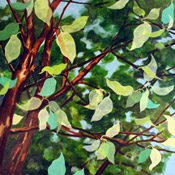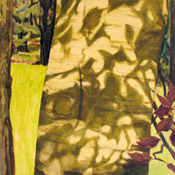A Dance to the Music of Time
This exhibition of oil paintings by Sally Vagliano Pettus is both a new departure and a return to roots. Pettus, whose career as a painter of woodland scenes burgeoned in the 1980s, took a long furlough from brush and oil with the dawn of the millennium. From 2000 until the day before yesterday, she devoted herself largely to sculpture, creating two remarkable series of bronzes. One is a sort of bestiary, a group of miniature fantasy creatures in which playfulness and psychological piquancy compete for the viewer's attention. The second group of bronzes are in effect portraits of leaves, tree branches, and tree trunks. I say "portraits" because Pettus managed to instill these reminders of fecundity and decay with an unforgettable individuality and pathos. Ranging in size from four or five inches to a dozen feet or more, these beautifully crafted objects beguile the eye even as they sound a somber, autumnal note.
That doubleness--a seductive, aesthetically pleasing surface in tandem with meditative poignancies--is a hallmark of Pettus's work. This new series of oils continues to exploit that doubleness. Viewers familiar with Pettus's work from the 1980s will notice many continuities. There is the obvious similarity of ostensible subject matter, for example. We are once again trekking along woodland paths. There is a similarity of palette, too, which features certain highly saturated greens modulated by a spectrum of burnished yellows, tawny browns, grays, and a hundred shades of lichen white and silver, punctuated by black traceries and the occasional thunderbolt of iridescent orange.
A deeper continuity involves the subject behind the subject. Although Pettus's nature scenes (the ones I recall, anyway) include no people or any emblems of human habitation, they have always seemed, curiously, to be inhabited--or perhaps I should "to have been inhabited." In Burnt Norton, T. S. Eliot spoke of roses that "Had the look of flowers that are looked at." Pettus communicates something similar in her paintings. The wooded path, the fallen branch, the floating leaf are part of an encompassing natural cycle that conspicuously includes humanity. Another doubleness: that humanity subsists both as an observer that transcends the parade on view and also as a participant in that parade, that passing. "Leaves like the things of man you with your fresh thoughts care for," as Gerard Manley Hopkins put it in "Spring and Fall." Ultimately, though, "It is Margaret you mourn for."
But for all the continuities one sees in Pettus's art, these paintings also mark a new departure. Visually, the most striking departure concerns the scale of the objects pictured. It is as if Pettus came to the easel with a magnifying glass. We have zoomed in on these trees, these leaves, these wild plants. But they are seen not under a microscope but what we might call a macroscope. There is a certain formal distillation going on in many of these paintings, a schematization of what is portrayed. If "abstraction" were not such a fraught word in writing about art I would say that these paintings also bespoke an increase in abstraction in comparison with their older cousins. There persists a natural sumptuousness in these pictures (consider, for example, "Forty-Five Leaves","Daffodil", or "Autumn Tapestry"), but it is a drier, more stately, less cluttered sumptuousness.
In part, there is the common recognition that just as every spring contains the seeds of the winter that will follow, so every winter includes the dream of future springs. But there is something more. The immediate pleasure one takes in these paintings--the fact, to put it bluntly, that they are beautiful and very well-executed works of art--betokens part of the contending buoyancy I have in mind. Art has traditionally been seen as a refuge, however temporary, against the ravages of time. And so it is. But ultimately what makes these pictures so fetching is the recognition they embody that time is not only the thief of every human aspiration and achievement. It is also the precondition for every human success. Time is the great provider as well as the great devourer.
It is enough that Sally Pettus has given us this magnificent suite of paintings. What an added bonus that they should be as deep, and deeply felt, as they are aesthetically bewitching.
--Roger Kimball
Roger Kimball is Editor of The New Criterion and Publisher of Encounter Books.

